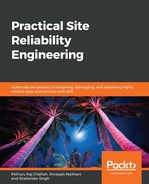The code bases of different companies often grow exponentially and increase in complexity. In a monolithic process, we have multiple independent development teams. These teams are not actually that independent at all; they simultaneously work on the same code bases and change the same sections of code. It is tough for new developers to contribute to the business, and the development process is slow. Because of this, we have seen a gradual shift toward microservices.
The following diagram shows the microservice container, the business logic image container, the data access layer container, and, in total, a working model of a microservice-based distributed model:

The Spring Framework is an enterprise Java framework that lets us write enterprise Java applications. Spring Boot is the way in which we can bootstrap, or quickly start, a simple Spring application. We can also build more complex applications quickly using Spring Boot. It allows us to create a production-ready application easily.
Let's think about what Spring Boot actually is. Spring is something we are already familiar with, that is, a framework to create enterprise Java applications. It is a huge framework and has a lot of different functionalities. Boot is something that enables you to bootstrap a Spring Framework. The official definition found at https://spring.io/ states: Spring Boot makes it easy to create stand-alone, production-grade spring-based applications that you can run.
Let's talk about primary characteristics of Spring Boot:
- Convention over configuration: Spring Boot has certain default configurations that can be used in applications. If necessary, we can change these according to our requirements, but these default configurations make building applications with Spring Boot much faster. There is often no configuration necessary. Let's look at an example: if we had 100 different things to do to configure something, we can often use the default configuration for 80% of those tasks.
- Stand-alone: Typically, when you build Spring applications, you are building a war file or a web application that you are going to deploy over Tomcat or any container or application server. With Spring Boot, however, what you get are stand-alone applications that you can run directly. You don't need to use any application servers or containers for deployments.
- Production ready: We don't need to do anything else to make microservices ready for production.
